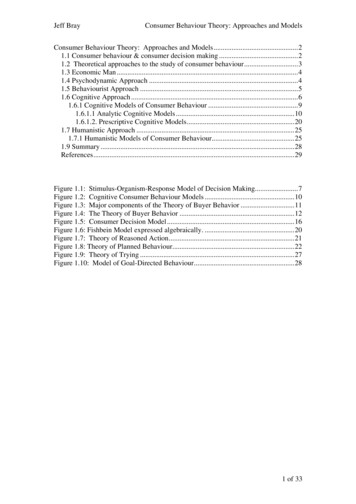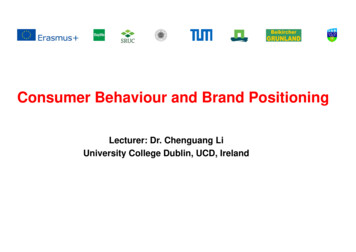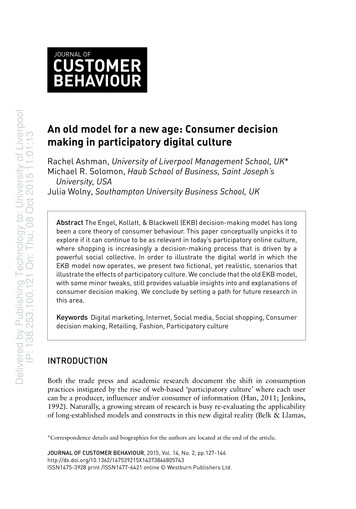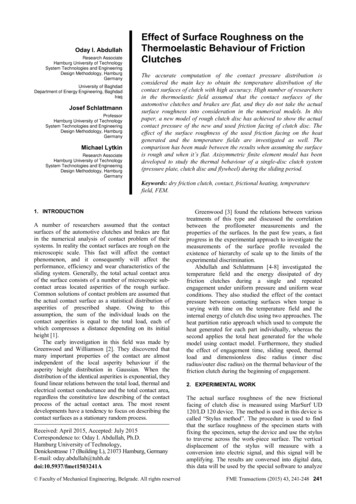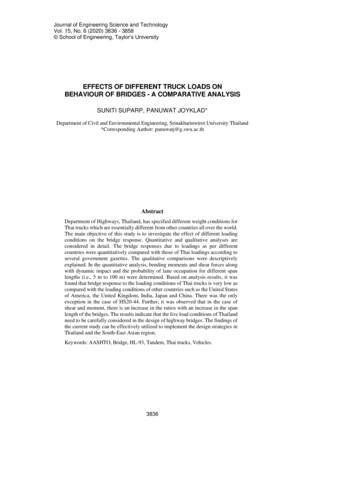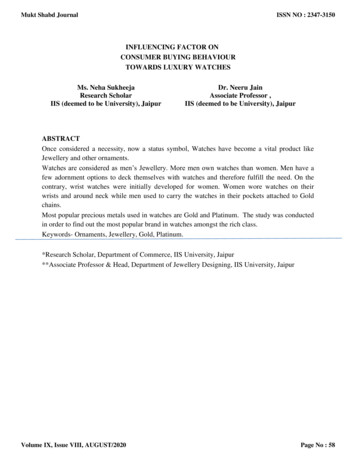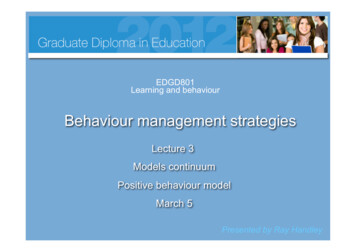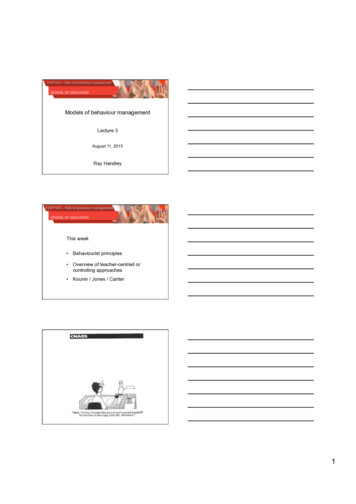
Transcription
EDPP302 – Risk and behaviour managementModels of behaviour managementLecture 3August 11, 2015Ray HandleyEDPP302 – Risk & behaviour managementThis week Behaviourist principles Overview of teacher-centred orcontrolling approaches Kounin / Jones / Canter1
Empathic listeningSome key principles:! More listening than talking! Responding with acceptance andempathy, not with indifference,cold objectivity or fake concern.! Trying to understand the feelingscontained in what the other issaying, not just the facts or ideas.! Restating and clarifying what the otherhas said, not asking questions or tellingwhat the listener feels, believes or wants.! Responding to what is personal rather thanto what is impersonal, distant or abstract.! Sensing of the other's frame of reference while avoiding thetemptation to respond from the listener's frame of reference.Empathic listening scriptA simple script:Intro! What happened?! Can you tell me what happened?ctiveRefleingntelislentiaInfluryamsum! You feel angry when . . . .! So you are angry/frustrated/disappointed that . . . .! You think it is unfair when . . . .pickedon .are. . angry that . . . . . .!! ItSoseemslet melikeseeyouif I arehavebeingit right.So youand frustrated with . . . . . . . And when this happens(the issue in your words from what you have understood.while listening to the other person).Raymond videoA simple example2
hescaoprt apsiruavioheBBehaviourist approaches7 things games teach us about learning:1. Measure progress2. Multiple short and long term goals3. Reward effort4. Rapid, clear feedback5. Uncertainty6. Increases attentiveness and memory7. Interaction with othersChatfield 2010digital video gamesLimit Setting/Controlling ModelsAssertive Discipline – Canter & CanterPreventive Discipline - Jacob KouninPositive Classroom Discipline - Fred Jones3
Characteristics of the ModelsStudents require firm direction from teachersLearning and behaviour are closely linkedPositive classroom relationships allow teachersto be trusted and respectedDisruptive behaviour occurs in all classrooms.Good teachers use techniques to negate itsimpact on learningTHE CRISIS CYCLEIntegrated experienceanxietyExternal controltensionivetns lianfepde omcnnoIntervention optionsStaff actionsInternal controlClient actionsactingredionu ctoutLimit Setting/Controlling ModelsPreventive Discipline - Jacob KouninPositive Classroom Discipline - Fred JonesAssertive Discipline – Canter & Canter4
Preventive Discipline - Jacob Kounin! teaching and discipline need to be integrated! interested, stimulated and active learners reduce the risk ofdisruptive behaviour! planned and coordinated activities within lessons reducethe likelihood of disruptive behaviour! a positive, productive classroom atmosphere or tone ispervasive for all participantsPreventive Discipline - Jacob Kounin! Ripple Group alerting By correcting misbehaviours in onestudent, it often influences the behaviourof nearby students Conversely, noticing positive behaviour inone or a small group of students drawsthe attention of the others to yourexpectationsKounin, Jacob S. (1970) Discipline and Group Management in Classrooms. Holt, Rinehart and Winston, Inc.TEXT from http://wik.ed.uiuc.edu/index.php/Kounin, JacobPreventive Discipline - Jacob Kounin!Ripple effect! Withitness!Overlapping!Smoothness!Momentum!Group alerting Always be alert to sights and sounds in theclassroom. Arrange the seats so that students are alwayswithin eyesight. Scan the room when working with individualsor small groups of students. When helping anindividual make sure that you do not haveyour back to the rest of the class. Briefly acknowledge misbehavior at firstdetection to let the class know that you know.Do not let the misbehaviour escalate beforeaction is taken.Kounin, Jacob S. (1970) Discipline and Group Management in Classrooms. Holt, Rinehart and Winston, Inc.TEXT from http://wik.ed.uiuc.edu/index.php/Kounin, Jacob5
Preventive Discipline - Jacob Kounin!Ripple effect!Withitness! Overlapping!Smoothness!Momentum!Group alerting When instructing one group, the teachershould be able to acknowledge difficultiesthat students outside of the group may behaving so that instruction continues moving. This also includes distractions from outsidethe classroom such as notes from the officeor students walking through the hallways.Kounin, Jacob S. (1970) Discipline and Group Management in Classrooms. Holt, Rinehart and Winston, Inc.TEXT from http://wik.ed.uiuc.edu/index.php/Kounin, JacobPreventive Discipline - Jacob Kounin!Ripple effect!Withitness!Overlapping! Smoothness!Momentum!Group alerting Preplan the lesson so that extraneousmatters are realised ahead of time andtaken care of. Supplies for the class shouldalways be preorganised before class beginsand close to where they will be used. Once students are doing their work andengaged, do not distract them. Leave themto their work and assist individuals withquestions or needs.Kounin, Jacob S. (1970) Discipline and Group Management in Classrooms. Holt, Rinehart and Winston, Inc.TEXT from http://wik.ed.uiuc.edu/index.php/Kounin, JacobPreventive Discipline - Jacob Kounin!Ripple effect!Withitness!Overlapping!Smoothness! Momentum! Keep the lesson moving briskly. Do not over-dwell on a minor or alreadyunderstood concept. Correct students without nagging andquickly return to the lesson. Have students move from one activity tothe next without being forced to wait foreach other and each step in the transition.Group alertingKounin, Jacob S. (1970) Discipline and Group Management in Classrooms. Holt, Rinehart and Winston, Inc.TEXT from http://wik.ed.uiuc.edu/index.php/Kounin, Jacob6
Preventive Discipline - Jacob Kounin!Ripple effect!Withitness!Overlapping!Smoothness!Momentum Calling on students at random by asking aquestion only after scanning the room tomake sure students are paying attention. Raising group interest by interspersingsuspense between questions.! Group alerting Having the entire class respond in unison. Physically moving around the room andasking students to show what they havedone. Asking one student to respond and looking atothers.Kounin, Jacob S. (1970) Discipline and Group Management in Classrooms. Holt, Rinehart and Winston, Inc.TEXT from http://wik.ed.uiuc.edu/index.php/Kounin, JacobLimit Setting/Controlling ModelsPreventive Discipline - Jacob KouninPositive Classroom Discipline - Fred JonesAssertive Discipline – Canter & CanterPositive Discipline - Fred JonesClassroom management procedures must . . . .! be positive and gentle.! set limits and build cooperation in the absence of coercion! be economical, practical and simple! ultimately reduce the teacher's work load.! offer incentives and encouragement for positive effortJones, Fred (2000) Tools for Teaching. Santa Cruz, CA: Frederick Jones and Associates.7
Positive Discipline - Fred JonesThree different management methods are integrated to forma three-tier approach to discipline management.! Limit-setting‘limit-setting andrelationship building forma tier of the managementsystem which we mightbest describe as theinterpersonal-interactivelevel of management.’from http://www.fredjones.com/Positive Discipline/Discipline Ch18.htmlPositive Discipline - Fred JonesThree different management methods are integrated to forma three-tier approach to discipline management.! Limit-setting! Incentive systemsmake the exchange ofpositive and negativesanctionsprearranged, explicit,concrete, and public.from http://www.fredjones.com/Positive Discipline/Discipline Ch18.htmlPositive Discipline - Fred JonesThree different management methods are integrated to forma three-tier approach to discipline management.! Limit-setting! Incentive systems! Back-up systemsnegative sanctionsprovide a disincentive,or the containment ofbehaviour when cooperation is lostfrom http://www.fredjones.com/Positive Discipline/Discipline Ch18.html8
Positive Discipline - Fred JonesThere are seven steps in limit setting:! Eyes in the back of your headPositive Discipline - Fred JonesThere are seven steps in limit setting:! Eyes in the back of your headStop what you are doing andconcentrate on the disruption! Terminate InstructionPositive Discipline - Fred JonesThere are seven steps in limit setting:! Eyes in the back of your headStop what you are doing andFacethe student,eyeconcentrateon themakedisruptioncontact, and remain calm! Terminate Instruction! Turn, look, and say the student’s name9
Positive Discipline - Fred JonesThere are seven steps in limit setting:! Eyes in the back of your head! Terminate InstructionFace the student, makeeye contact,Walk calmlyto the andfrontremainof thecalmstudent’s desk and avoid comments! Turn, look, and say the student’s name! Walk to the edge of the student’s deskPositive Discipline - Fred JonesThere are seven steps in limit setting:! Eyes in the back of your head! Terminate InstructionWalk calmly to the front of theDemonstrate what is expectedstudent’s desk and avoid comments! Turn, look, and say the student’s name! Walk to the edge of the student’s desk! PromptPositive Discipline - Fred JonesThere are seven steps in limit setting:! Eyes in the back of your head! Terminate InstructionDemonstrateLeanwhattowardsis expectedthe student! Turn, look, and say the student’s name! Walk to the edge of the student’s desk! Prompt! Palms10
Positive Discipline - Fred JonesThere are seven steps in limit setting:! Eyes in the back of your head! Terminate InstructionShift andLeanmaintaineye thecontacttotowardsstudentshow you are still aware! Turn, look, and say the student’s name! Walk to the edge of the student’s desk! Prompt! Palms! Camping outPositive Classroom Discipline - Fred JonesSocial cognitive theoryModelling & controlIn social learning theory, Albert Bandura (1977) statesbehaviour is learned from the environment through theprocess of observational learning.Common t11
Limit Setting/Controlling ModelsPreventive Discipline - Jacob KouninPositive Classroom Discipline - Fred JonesAssertive Discipline – Canter & CanterAssertive Discipline – Canter & Canter! Teachers have the right to determine what is best foryour students, and to expect compliance.! No pupil should prevent you from teaching, or keepanother student from learning.! Student compliance is imperative in creating andmaintaining an effective and efficient learning environment.! To accomplish this goal, teachers must react assertively,as opposed to aggressively or non assertively.Hostile Teachers! see students as adversaries! use an abrasive, sarcastic and hostile style! focus on the person not on the behaviour! meet their own needs but disregard the needs of the students12
Non-assertive Teachers! ignore or react in desperation! use a passive, inconsistent, timid and non-directive manner! do not communicate their needs to the students! show an uncertainty and fear of the studentsAssertive Teachers! respond confidently, politely and quickly! give firm, clear, concise directions to students! build positive, trusting relationships! are demanding, yet warm in interaction! listen carefully to what their students have to say,and treat everyone fairly (not necessarily equally).Assertive Discipline – Canter & CanterfeaetursClear set of observable, class negotiated rules. Only 3 - 5 max.For behaviour that breaks the rules a clear, pre-determinedset of consequences are laid out.Focus on positive behaviour with constant reinforcementthrough comments and recording of compliance.All students are targeted for both positive recognition andnegative consequences when relevant.13
CLASS RULESNo talking when theteacher is talkingStay in your seatsKeep your hands and feetoff other people and theirpropertyFollow the instructionsgiven by the teacherCONSEQUENCES1stname on board 1st warning2ndtick - 2nd warning3rdtick - 3rd warning4thtick - stay backafter class5thtick - lunch timedetention6thtick - leave theclass, interview with HT/APCLASS CONSEQUENCESCLASS RULES1st incidentname on board - 1st warningNo talking when the teacheris talking2nd incidenttick - 2nd warningStay in your seats rd3rd incidenttick - 3 warningyour handsfeetbackoff other4thKeepincidenttickand- stayafter classpeople and their property5th incidenttick - lunch time detentionFollow the instructions given by the6thteacherincidenttick - leave the class, interviewwith HT/APCLASS RULESNo talking when the teacheris talkingStay in your seatsKeep your hands and feet offother people and their propertyFollow the instructions givenby the teacherCONSEQUENCES1stname on board 1st warning2ndtick - 2nd warning3rdtick - 3rd warning4thtick - stay backafter class5thtick - lunch timedetention6thtick - leave the class,interview with HT/APIs it worth it?Caleb Fabio SuzieJack Bashir ShannonCarly JessRyan Hassan TamikaLucasCommon pitfalls with Assertive DisciplineStudents will not stop behaviours and often will be pushedto get more ticks as a challenge or act of revengeTicks are delivered as punishment/consequences notcues/signalsThe list of students will be selective rather than inclusiveTicks are delivered only to certain students in the classNo evidence of a ripple effectPositive comments to compliant students are notused enough or they are insincereLittle dilemma for students to changeAppropriate positive consequences are not in place14
Quick guide to handling defianceQuick Guide to defianceA QuickGuide to managing defianceStay calm / Detach / Take a breathTactically ignore / keep detaching / refocusRespond to anxiety / use negotiating question /introduce confusion / refocusNoSeek helpI’m not doing itFuck youTony Attwood'sPerspective on Aspergers (ASD)Asperger Friendly ClassroomWhat motivates an “aspie”? Completion - getting tasks finished No errors - perfectionism,
Preventive Discipline - Jacob Kounin Positive Classroom Discipline - Fred Jones . 4 Characteristics of the Models Students require firm direction from teachers Learning and behaviour are closely linked Positive classroom relationships allow teachers to be trusted and respected Disruptive behaviour occurs in all classrooms. Good teachers use techniques to negate its impact on learning s .
